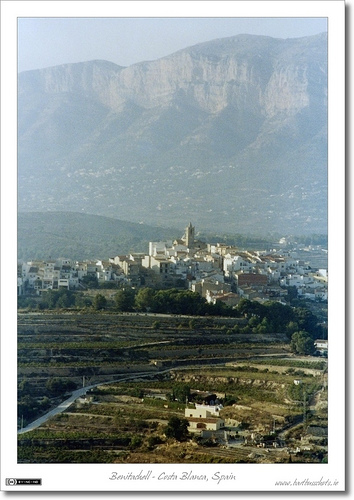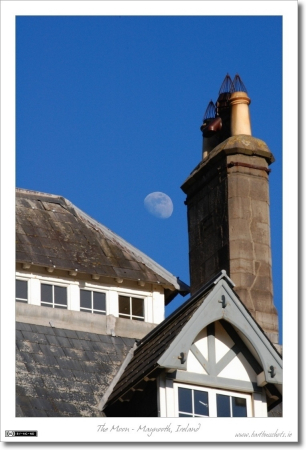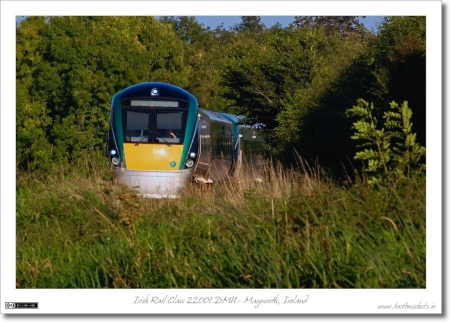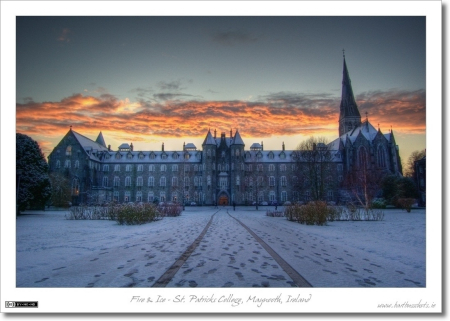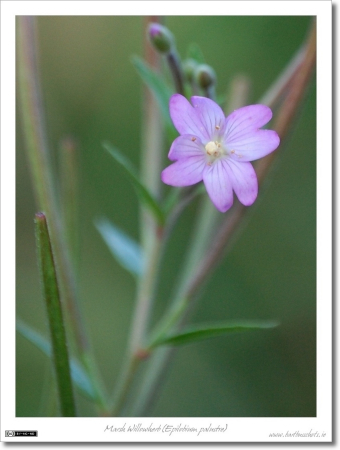Mar
10
Photo of the Week 55 – Benitachell
Filed Under Photography | 2 Comments
This week I’ve chosen another scan of one of my old Olympus OM-1 shots. In this case from September 2000 in Spain on a family holiday. This particular shot was taken within walking distance of my parent’s place just outside the village of Moraira on the Costa Blanca. If you head up the mountain behind the house you end up with some lovely views of the valley below, and with a zoom lens you can pick out some of the neighbouring villages, including the small town of Benitachell. I particularly like this shot because of the layering of the small hill the village is on, and the mountains in the background. I also like the way the church is still the tallest building is the village, just like it was a hundred years ago.
Mar
1
I fell in love with this shot the moment I saw it importing into iPhoto. I’m not even sure it’s technically a good photo, but I just love it.
I took this shot from St. Mary’s Square on the grounds of St. Patrick’s College (AKA the NUI Maynooth South Campus). For those of you who’ve visited the campus, that’s the square with the cool water garden in it next to the College chapel. I’ve always loved the architecture of the buildings around this square, and in particular these little sun-roofs. You have these little sunroofs on both St. Mary’s and St. Patrick’s House, but these ones are on St. Patrick’s House. It was quite hard to get this shot without getting a wet foot, but I eventually managed to line everything up correctly and get the shot, even if I was at quite a stretch.
- Camera: Nikon D40
- Lens: Nikon DX AFS 55-200mm
- Exposure: 1/400 sec
- Focal Length: 200mm
- Focal Ratio: F22
- ISO: 800
- Camera Mode: Aperture Priority
- Exposure Bias: -0.76
Feb
28
Why Do I Shoot RAW?
Filed Under Photography | 2 Comments
This post is my attempt to organise my thoughts in advance of this week’s Chit-Chat Across The Pond segment on this week’s NosillaCast. This is of course just my initial thoughts for starting a conversation, so this post will be less than half of what you’ll get if you listen to the actual show!
So, what’s all this about then? On higher-end digital cameras (including some point-and-shoot models), you can either save your images as JPEGs, or as so-called RAW files. RAW is a sort of blanket term, it’s not a standard, and it’s different for different makes of camera. RAW files also have different file extensions for the different RAW formats. On my Nikon for example, RAW files are saved with a .NEF file extension. What these formats do all have in common is that they save the raw data that is collected by the camera’s sensor, hence the name.
RAW files are bigger than JPEGs, so that’s the trade-off, there are however many advantages to be gained in exchange for that lost disk space. In this post I’m going to talk about the advantages RAW offers me, and why I choose shoot RAW over JPEG these days. This is not an exhaustive list of the advantages of RAW, and others will have different reasons for shooting RAW.
Feb
26
Why I Don’t Like RedHat Enterprise Linux
Filed Under Computers & Tech, System Administration | 1 Comment
NOTE: Although this post references experiences I have had in work, the opinions expressed here are mine and mine alone.
If you follow me on Twitter you may have noticed my anti-RHEL (RedHat Enterprise Linux) outbursts today. I could keep twittering to try make my point, but sometimes 140 characters is just not enough, so I figured I’d blog about it instead and then tweet out the link to the blog post when I’m done.
In work we run two kinds of Linux servers, RedHat Enterprise Linux, and CentOS. We pay for RedHat, we don’t pay for CentOS (because it’s free). CentOS is based off the RedHat code base, but has some of the fancy stuff stripped out. Clearly, you would expect RHEL to give you the better experience since it has more features and you pay for support. Unfortunately, in my experience that’s just not how things are shaping up. CentOS has been completely problem and stress free (as well as financially free), while RHEL has not been such a smooth ride. Sure, most of the time it works just fine, but it definitely generates more stress for me than CentOS does, and that’s paid-for stress!
Feb
25
Photo of the Week 53 – Rounding the Corner
Filed Under Photography | 2 Comments
This is a photo I shot a while ago, but I re-visited it recently and tweaked the crop and the processing and now I’m much happier with it, happy enough to use it as a photo of the week in fact!
This is an Irish Rail class 22001 Diesel Multiple Unit (DMU) rounding the sharp corner on the approach to Maynooth from the Dublin side. The shot was taken from the towpath of the Royal Canal which runs next to the track for much of the line’s length. Because the canal is lower than the tracks, and because the vegetation along the canal and the tack was in full summer growth, you can’t see the tracks at all, giving the image a rather strange feel. I also quite like these new modern InterCity trains. As well as being much quieter and more comfortable than their predecessors, these new trains also look quite stylish and modern.
- Camera: Nikon D40
- Lens: Nikon DX AFS 55-200mm
- Exposure: 1/1600 sec
- Focal Length: 200mm
- Focal Ratio: F11
- ISO: 800
- Camera Mode: Aperture Priority
- Exposure Bias: -1.0EV
Feb
18
Photo of the Week 52 – Fire & Ice
Filed Under Photography | 5 Comments
It’s hard to believe I’ve been doing these weekly posts for a year now! I’m so glad this idea worked out, it’s really helped my keep blogging and keep taking photos.
This shot was taken in St. Joseph’s Square on the St. Patrick’s College Campus (AKA NUI Maynooth South Campus) in Maynooth, Ireland. It was taken later the same day as the photo I used for Photo of the Week 50. After it stopped snowing we got a really dramatic sunset over the freshly whitened landscape. It was an amazing sight to behold. The shot was taken from the middle of St. Joseph’s Square looking west towards St. Patrick’s House, and shows two of the campus’s best known landmarks, the President’s Arch (the door between the two towers), and the Gunne Chapel (AKA the College Chapel).
- Camera: Nikon D40
- Lens: Nikon DX AFS 18-55mm (D40 kit lens)
- Exposure: 1/160 sec
- Focal Length: 18mm
- Focal Ratio: F8
- ISO: 800
- Camera Mode: Aperture Priority
- Processing: This image was generated from a single RAW file converted to a pseudo-HDR image and then tone-mapped with Photomatix Pro. You can see the un-tone-mapped version here.
Feb
14
First Impressions of the Postbox Beta
Filed Under Computers & Tech | 2 Comments
As some of you probably know, I’m a long-time Thunderbird user, from back when it still had the cool blue Phoenix logo, and when what we now call FireFox had only just changed from being called Phoenix to FireBird. In other words, from when Mozilla still looked at BOTH their browser AND their mail client as being important products. Since those days I’ve watched in horror as Mozilla first neglected Thunderbird, and then abandoned it. While FireFox has gone from strength-to-strenght, Thunderbird has languished. The project was effectively thrown out of Mozilla and left to fend for itself. It also lost its lead author, and has stagnated. It’s a good mail client, but it’s behind the times. It’s missing simple features like a tabbed interface, and FireFox 3’s new, non-retarded, way of dealing with problem security certs. For all these reasons I was very excited to see the announcement of a beta version of Postbox this week. It’s a fork of Thunderbird being led by Thunderbird’s old lead, so in many ways, it’s a glimpse of where Thunderbird could have been, had it not been neglected by Mozilla. It definitely is a beta, but it’s a glimmer of hope at long-long-last!
Feb
11
Photo of the Week 51 – Marsh Willowherb
Filed Under Photography | 2 Comments
I’m a little bit late again this week, though I’m a day less late than I was last week … so progress at least 🙂
Anyhow, the photo I’ve chosen for this week is one I shot last autumn along the towpath of the Royal Canal near Maynooth, or, to be more precise, between Pike’s Bridge and Deey Bridge. This is a closeup of a single Marsh Willowherb (Epilobium palustre) flower.
- Camera: Nikon D40
- Lens: Nikon DX AFS 55-200mm
- Exposure: 1/200 sec
- Focal Length: 200mm
- Focal Ratio: F8
- ISO: 800
- Camera Mode: Aperture Priority
- Exposure Bias: -0.67
Feb
9
So when atheists applied to have the slogan “There’s probably no God. Now stop worrying and enjoy your life” put on buses, the Christian right responded by insisting that this was false advertising because it asserts a claim that cannot be substantiated. You’ll note that the atheists chose to use the qualifier “probably”. The Advertising standards authority thankfully agreed that with the probably in there the atheist ad is just fine. So how do the Christian right respond? Why, with adverts of their own. How do these ads stand up to the yardstick they insisted be applied to the atheist ads? They don’t. You’ll see no “probably” in the Christian ad. They make no bones about making a direct statement that is physically impossible to back up. If you believe that there is no evidence to say that there is “probably no God”, you can’t possibly also believe there is evidence that there is “definitely a God”, yet that’s exactly what the Christian ads say:
There definitely is a God. So join the Christian Party and enjoy your life.
Now, it’s important to stress that the organisation which filed the complaint against the atheist bus slogan is not the same organisation that is paying to have the above ad put on buses. It was Christian Voice which objected to the atheist add, and it’s the Christian Party which is paying for the above ad. Now, the question has to be, will Christian Voice lodge a complaint against the Christian Party ad? Or are they happy with a double-standard if it’s a pro-Christian double-standard?
Mind you, I have a feeling this could turn into a fantastic own goal! With this ad out there, there is no no way an appeal can be lodged against an atheist ad that omits the word “probably”. If I were running the Atheist Bus campaign, I know what I’d be doing next 🙂
Feb
7
Quick Review of Maperture
Filed Under Photography, Computers & Tech | 2 Comments
Maperture is a free geo-tagging plugin for Apple’s Aperture photo management and editing software. This plugin will not be of interest to everyone. Unless you care about inserting latitude and longitude information into the EXIF data of photographs, you will have no interest in this what-so-ever. In fact, I’d go even further, I’d posit that this initial version of Maperture is only for people who care about embedding location data into their photos, but who don’t have a GPS device. Future versions (one of which is in beta ATM) will be of more interest to more people, but right now Maperture is for those of us who need to use Google Maps to find the co-ordinates of our pictures because our cameras can’t do it for us. This software really feels like a 1.0 product though. You can see it has massive potential, but right now it’s still rather rough around the edges.







